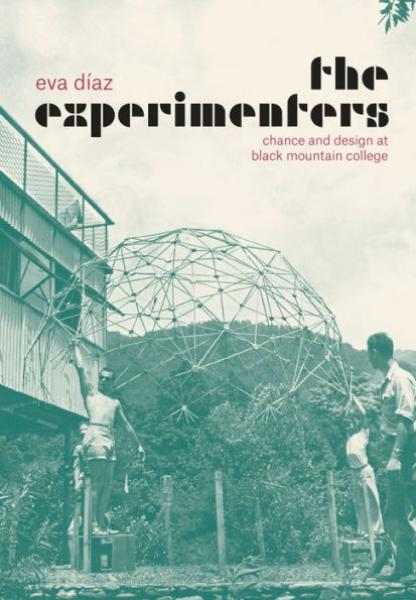Description
Díaz's focus is on experimentation. Albers, Cage, and Fuller, she shows, taught new models of art making that favored testing procedures rather than personal expression. These methodologies represented incipient directions for postwar art practice, elements of which would be sampled, and often wholly adopted, by Black Mountain students and subsequent practitioners. The resulting works, which interrelate art and life in a way that imbues these projects with crucial relevance, not only reconfigured the relationships among chance, order, and design--they helped redefine what artistic practice was, and could be, for future generations.
Offering a bold, compelling new angle on some of the most widely studied creative figures of modern times, The Experimenters does nothing less than rewrite the story of art in the mid-twentieth century.
One of the most famous art schools in the US in the 1940s and 1950s was Black Mountain College, located in the rural heart of the Blue Ridge Mountains near Asheville, North Carolina. The war in Europe drew an astonishing array of artists and writers to its classrooms and studios. Bauhaus instructor Josef Albers ran Black Mountain College from 1938 to 1949, turning it into one of the most progressive schools in the country. Looking backward one can see that practically everyone who was anyone or became someone in the arts did a stint at Black Mountain, as faculty or student --or both: John Cage, Harry Callahan, Robert Creeley, Merce Cunningham, Willem and Elaine de Kooning, Robert Duncan, Buckminster Fuller, Walter Gropius, Alfred Kazin, Franz Kline, Jacob Lawrence, Charles Olson, Ben Shahn, Arthur Siegel, Aaron Siskind, Theodoros Stamos, Jack Tworkov, Robert Motherwell, Peter Voulkos, Robert Rauschenberg, Cy Twombly, John Chamberlain, Kenneth Snelson, and Ray Johnson. Until now scholars have depicted the college as a prologue in the careers of these artists. That, however, is changing. The Experimenters is the first study to examine how three key Black Mountain instructors--Josef Albers, John Cage, and R. Buckminster Fuller--taught new models of art making using the concept of experimentation. Focusing on specific studio projects, the book explores how faculty and students based their art on testing procedures rather than on personal expression. These procedures reconfigured the relationships among chance, order, and design, and helped redefine what art could be--and did become--for future generations.
Eva Díaz is assistant professor of art history at the Pratt Institute.
"By parsing three different versions of experimentation--performed by Josef Albers, John Cage, and Buckminster Fuller--Díaz shows us how their individual efforts were part of a shared commitment to art's capacity to reinvent the world, to alter how we see, experience, and shape it in our own image. In the name of experimentation each of the artists suspended, if only for a moment, the metrics of failure and success, and replaced them instead with the values of intellectual pleasure, expanded sensory experiences, and aesthetic innovation. While the book is undoubtedly a historical account of a particular time and place, it is also a road map for many paths that, while not taken, still remain open."--Helen Molesworth, Museum of Contemporary Art, Los Angeles
"In this highly evocative and well-executed study, Díaz explores the innovative pedagogical practices that were developed at Black Mountain College in its heyday. Respectful of the distinct teaching methods of the College's most notable faculty, Diaz nonetheless finds a common experimental basis to the artworks and inventions produced by their students in the late 1940s and early 1950s. The Experimenters is nuanced, erudite, and intellectually wide-ranging. It will be essential reading for anyone interested in the development of mid-twentieth-century art in the United States."--Alexander Alberro, author of Conceptual Art and the Politics of Publicity
"Terrific. Black Mountain College has long been a lodestone for those interested in alternative educational models and in artistic innovation. Nevertheless, the major historical literature on the College still rests on largely anecdotal histories, with a tendency to jaunty optimism in lieu of criticality. There is nothing quite like The Experimenters out there--not on Black Mountain College, not on art making, and not on pedagogy."--Judith Rodenbeck, Sarah Lawrence College
"Highly enjoyable and even inspirational for anyone interested in art practice or simply the power of challenging accepted ways of thinking. . . . Reminds us that the restless spirit of experimentation is often best fostered in environments that expose the rules governing life and art before pushing us, in a collective effort, to break them."-- "MAKE Literary Magazine"
"Insightful. . . . What distinguishes this book is Díaz's lucid, comprehensive explanations of the ways in which Albers, Cage, and Fuller employed experimentation, or chance, and even failure as agents to advance perception in art specifically and, more broadly, to improve society and the body politic. . . . Highly recommended."-- "Choice"
"Provides readers with clarity and elucidation about a college, three of its professors and an outside-the-mainstream educational experience. . . . Engaging."-- "New York-Pennsylvania Collector"
"What links systems theorist and architect R. Buckminster Fuller with artistic innovators such as Josef Albers and John Cage? The answer is Black Mountain College, North Carolina. . . . As art historian Eva Díaz reveals in this engrossing study, their explorations in materials, form, chance, and indeterminacy were never less than electrifying. Her sympathetic portrait of Fuller as a utopian saving the world through geodesic geometry is particularly assured."-- "Nature"
"With well-developed prose and a good narrative, Díaz excels at providing context and content for an important story of experimentation on this campus and in subsequent locations inspired or directly impacted by the Black Mountain College approach to education."-- "Journal of Southern History"
Product Details
- University of Chicago Pre Brand
- Dec 25, 2014 Pub Date:
- 022606798X ISBN-10:
- 9780226067988 ISBN-13:
- 256 Pages
- 10.37 in * 7.26 in * 0.81 in Dimensions:
- 2 lb Weight:




